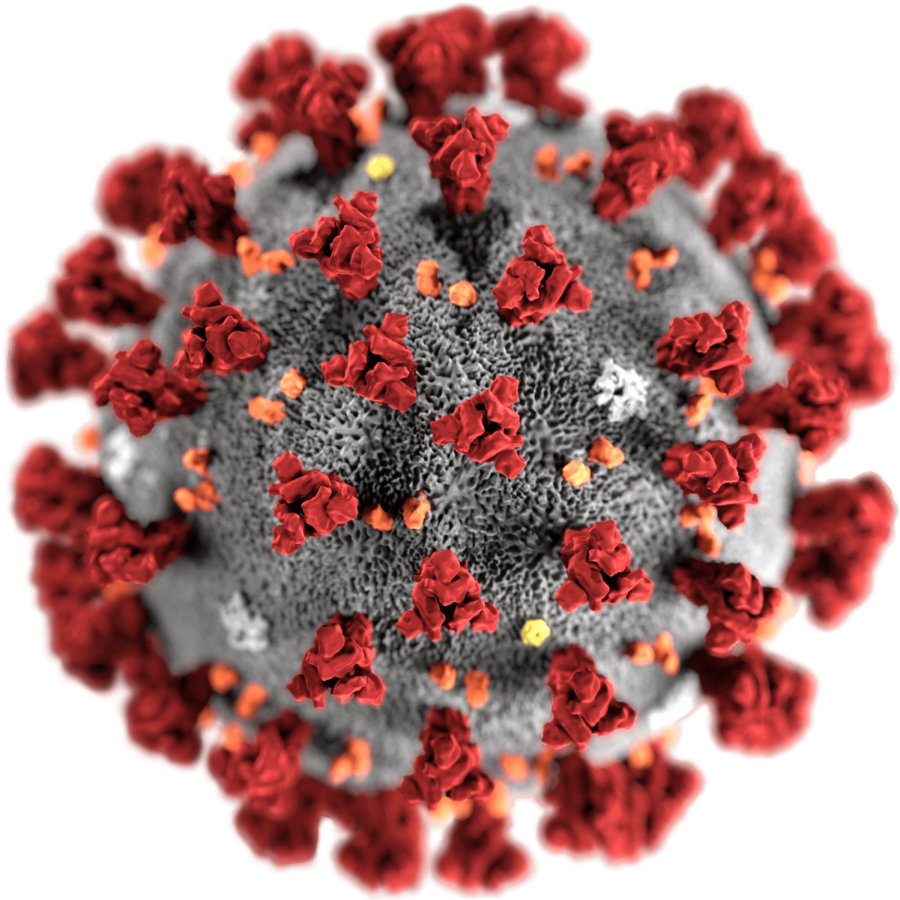Coronavirus Update: What You Need to Know
The coronavirus or COVID-19 is making its way around the globe, reaching the US almost two months after the first reported outbreak on December 31, 2019, in Wuhan, China. There seems to be an overwhelming amount of news on the virus and its impact on the world. Here are some simple facts and news update about the virus and how it’s making itself known.
An illustration of the coronavirus, created at the Center for Disease Control, highlights its stark shape. The coronavirus has swept the globe, infecting over 80,000 people. Photo courtesy of PHIL, #23312. Alissa Eckert, MS; Dan Higgins, MAM
March 2, 2020
We’ve all heard of the coronavirus, the big, bad, scary disease that had its debut in China and is now on the verge of being labelled a pandemic, defined by Merriam Webster as prevalent over a whole country or the world. It seems like another version of the 2016 Ebola outbreak, and just as inevitable and terrifying. But what do we really know about the virus?
First off, the coronavirus is a nickname for its CDC classification “SARS-CoV-2”, abbreviated to “COVID-19”. The virus has its origin in bats, funny enough, along with its two siblings, MERS-CoV and SARS-CoV. To be specific, the virus itself is called SARS-CoV-2. The sickness, the disease that causes the many flu-named symptoms of coronavirus is named covid-19. So SARS-CoV-2 causes covid-19, in the same way that HIV causes AIDS. Originally, World Health Organization, or WHO, officials found that those infected had contact with seafood or meat markets, indicating animal-to-person infection spread. However, the virus is now known to be spread by person-to-person contact.
Second, the coronavirus presents itself much as the flu. Symptoms include coughing, fever, and shortness of breath. The death rate of the coronavirus is 3.4% roughly. The death rate of the flu, in comparison, is only about 0.2%, but more people have died from the flu than the coronavirus. The problem comes when people are asymptomatic, meaning they are carrying the virus and actively spreading it but don’t have symptoms to signify a greater health risk. However, the CDC says that the US doesn’t have anything to worry about. “For the general American public, who are unlikely to be exposed to this virus at this time, the immediate health risk from COVID-19 is considered low,” said the official CDC report on the virus itself.
Here’s the link to the CDC file on the virus.
https://www.cdc.gov/coronavirus/2019-ncov/summary.html
One more thing to keep in mind. Your gender, age, and health all have something to do with your chances of survival should you contract the disease. Men have a higher mortality rate, at 2.8%, to women’s 1.7%. The statistics for the age demographic of students (10 to 19 years of age) show that the mortality rate for younger people is 0.2%. The risk of dying dramatically increased among patients in their 70s and 80s as many in this age group are more likely to have preexisting health conditions. Coronavirus patients with heart disease had a 10% mortality rate, while those with diabetes had around a 7% mortality rate. In conclusion, younger and healthier people have a better chance than older people or those with underlying health conditions.
Read more about the mortality rates here.
https://thehill.com/changing-america/well-being/prevention-cures/485144-coronavirus-fatality-rates-vary-dramatically
Here’s some quick briefs on the newer stats of the case.
The US’s First Case Contracted Through Unknown Means
The US has over 60 confirmed cases of the coronavirus, but out of the 60+ cases, almost all of them have been imported (contracted on a cruise that docked in Japan, repatriated out of Wuhan, the center of the outbreak, or were close to someone who just returned from China). Officials report four cases that cannot be traced back to a carrier or another infected person at all. The first case that had untraceable origins was located in California. Officials have not been able to trace where the patient got the disease, and it has scientists and citizens worldwide concerned. “This does appear to be a person who genuinely did acquire their illness in the community,” Californian Public Health Officer Dr. Bela Matyas said in a news conference on Thursday, Feb. 27.
The Second Reported Death in the U.S.
The second reported death from coronavirus comes from Washington as of Sunday, March 1, where a man in his 70s acquired the virus. As of Sunday, March 1, 88 cases of coronavirus have been confirmed. The first death was reported on Saturday, Feb. 29. New York just reported their first case, while there are five new cases in California, two in Florida, a second case in Oregon, and new cases in Illinois and Rhode Island. Over 50 individuals at the Life Care Center in Kirkland, Washington where the second coronavirus-related death occurred, are exhibiting respiratory symptoms.
States of Emergency
Washington has already declared a state of emergency, after the second coronavirus-related death and the infection of 50+ individuals at a nursing facility.
Florida declares a public health emergency after two reported cases.
San Francisco has declared a state of emergency in the nature of being prepared.
“This declaration of emergency is all about preparedness,” Mayor London Breed said during a press conference.
CDC Tests Were Faulty At First
South Korea has been able to test over 35,000 people while the United States has only tested 426 people, because tests sent out by the CDC included a faulty component. Testing was also based on a limited amount of factors, such as a direct travel link to mainland China, discounting any close countries or untraceable infections. “Experts are increasingly concerned that the small number of U.S. cases may be a reflection of limited testing, not of the virus’s spread,” the Washington Post reported.
Stock Market Tumble
The S&P 500 stock market index that measures the stock performance of 500 large companies listed on stock exchanges in the United States, had suffered its worst week since October 2008 financial crisis.“This is one of the few times in recent history where we’ve seen them meeting that with selling and not buying,” said Mike Lewis, head of U.S. equity cash trading at Barclays. People on Wall Street are scared and it shows in the pitfall of the Dow Jones and the S&P 500 index.
The Death Toll Tops 3,000
The majority of deaths are coming from mainland China, with over 88,000 cases reported everywhere in the globe with the exception of Antarctica.
Do we really need to be scared of the coronavirus? From the studies done of the virus and its impact on human life, anyone without underlying health conditions or old age should answer, “Not really.” And COVID has a much smaller death rate at about 3% compared to its siblings, SARS at 14-15% and MERS at 34.4%. However, a coronavirus host may infect 2 to 5.3 people, while SARS and MERS were both predicted to infect 1 to 2.9 people respectively. Coronavirus’s deadliness may just lie in its contagious nature and how unpredictable it is, as a result of how new it is. The outbreak was first reported in Wuhan, China, on Dec. 31, 2019.
Monitoring the situation is the best way to stay on top of the overwhelming amount of news streaming in about the virus and the climbing death toll.
To stay on top of the stats, follow this live tracker of all cases, deaths, and recovered patients:
https://www.worldometers.info/coronavirus/#countries




